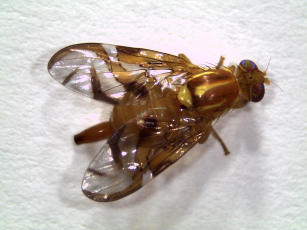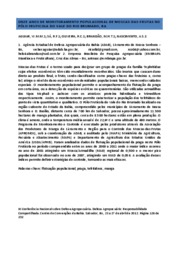Procedimentos para o monitoramento populacional de moscas-das-frutas (Tephritidae) em pomares comerciais
Procedures for population monitoring of fruit flies (Tephritidae) in commercial orchards

Photo: SANCHES, Nilton Fritzons
This agricultural practice aims to monitor the population of fruit flies (Tephritidae), providing important basic information of practical and theoretical orders for decision-making on the most appropriate time to initiate integrated pest control actions of national fruit production. It should be used in insect pest population suppression programs in commercial orchards aimed at the domestic and foreign markets. Through monitoring, it is possible to verify the abundance and population fluctuation of the species, enabling integrated control actions and also the detection of exotic or quarantined species.
The technique consists of installing, at strategic points in the orchard, a network of traps containing food or sexual attractants in order to know the appropriate time to initiate control actions. The success and efficiency of monitoring tephritid adults depends on the quality of the attractant (food or sex), the type of trap used and its correct location in the field.
In large-scale monitoring, two types of traps are used. In McPhail traps, for Anastrepha species, it is recommended to establish a weekly inspection frequency, removing all captured insects and placing them in 70% alcohol. In the Jackson type, for C. capitata, the insects are trapped when they come into contact with a sticky substance. Inspection and replacement of attractants takes place at intervals of three to four weeks.
Where to find:
Mais informações: https://bit.ly/3sEJ1av
Agricultural practice: For plant pest management Launch year: 2005
Country: Brazil Region: Central-West, Northeast, Southeast State: Distrito Federal, Goiás, Mato Grosso, Mato Grosso do Sul, Alagoas, Bahia, Ceará, Maranhão, Paraíba, Pernambuco, Piauí, Rio Grande do Norte, Sergipe, Amapá, Amazonas, Rondônia, Roraima, Tocantins, Espírito Santo, Minas Gerais, Rio de Janeiro, São Paulo, Paraná, Rio Grande do Sul, Santa Catarina Biome: Amazon Rainforest, Cerrado, Atlantic Rainforest, Caatinga
Responsible Unit: Embrapa Cassava & Fruits

